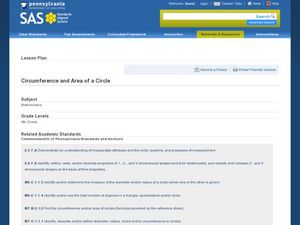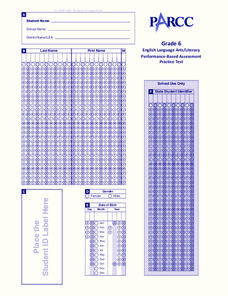Curated OER
Explore: 1st Grade Plant Observation
First graders grow seeds in a mini terrarium. They compare the root systems, stems, leaves, and flowers of the different plants. They categorize the plants and discuss the basic functions of plant parts.
Curated OER
Finding the Circumference and Area of a Circle
Sixth graders discover what circumference is. In this measurement lesson, 6th graders identify the radius and diameter of different circles. Students discover how to find the area of a circle using the radius and diameter.
Curated OER
Location, Location, Location
Students investigate the properties of triangles. For this geometry lesson, students identify the location of different polygons. They identify the different properties of triangles and polygons.
Curated OER
Nature of Science and Ecology
Young scholars identify the different biotic and abiotic components of an ecosystem. In this ecology lesson, students perform a case study on current environmental problems. They write a position statement about their chosen topic and...
Curated OER
Lemon Light
Students engage in a lesson which model different types of light refraction. They perform an experiment which uses lasers, jello and wax paper to illustrate how light refracts.
Curated OER
Child Care -- Arts and Crafts
Students continue their completion of the child care internet course. In groups, they examine the differences between arts and crafts and develop their own stations for their classroom. To end the lesson, they create their own art...
Curated OER
Color Psychology
Students develop a list of what they believe each feeling a color represents. Individually, they use the internet to research how different colors make us feel, behave or act. To end the lesson, they complete a worksheet and discuss...
Curated OER
Looking Toward a Higher Deity
Sixth graders study the tenets of the five major religions of the world. In this religion instructional activity, 6th graders investigate the tenets of Buddhism, Christianity, Hinduism, Islam, and Judaism by researching and recording on...
Curated OER
Triangle Classification
Students classify different types of triangles. In this geometry lesson plan, students identify and use properties of triangles. They differentiate between isosceles and equilateral triangles.
Curated OER
Diagonals to Quadrilaterals II
Students identify the properties of different polygons. In this geometry lesson, students find the slope of a line and calculate the distance between two lines. They differentiate between similar and congruent polygons.
Curated OER
Looking At the World Through Different Eyes
Pupils are introduced to the concept of reframing as a problem-solving alternative. They present the value of incorporating adults into their suport system. Students draw what they think Creep Face and Maggie saw when they looked...
McCook Public Schools
Vocabulary List - Microsoft Word Basics
Never forget a term used in Microsoft Word with these four pages of related vocabulary and their definitions.
Inside Mathematics
Conference Tables
Pupils analyze a pattern of conference tables to determine the number of tables needed and the number of people that can be seated for a given size. Individuals develop general formulas for the two growing number patterns and...
California Education Partners
Miguel's Milkshakes
Moooove over, there's a better deal over there! The fourth segment in a series of eight requires individuals to determine the best unit cost for milk. Scholars calculate the least amount they can spend on a particular quantity of...
Weather Bug
WeatherBug
Exploring the weather has never been more intriguing! Whether you are looking for a quick glance at the 10-day forecast, trying to figure out if lightning is heading your way, or wondering what the pollen count is, you will find out...
Maryland Department of Education
The Concept of Identity Lesson 7: Logical Fallacies
What are the effects of competition in an academic environment? The competition between the main characters in A Separate Peace motivates a series of activities that asks readers to take a stance on competition, and then to develop a...
Chicago Botanic Garden
Reflecting on What I Learned About Climate Change
After three eye-opening lessons about our environment, scholars revisit a 10-question survey, reflect on their new-found knowledge, and take action by writing to a representative or creating a public service announcement about...
California Education Partners
Least and Greatest
Squares can be magic. Pupils use their knowledge of addition of positive and negative rational numbers to create a 3 X 3 magic square where the sums are 1. Scholars create addition and multiplication expressions with a set of rational...
California Education Partners
T Shirts
Which deal is best? Learners determine which of two companies has the best deal for a particular number of shirts. They begin by creating a table and equations containing each company's pricing structure....
California Education Partners
Yum Yum Cereal
Design an efficient cereal box. Scholars use set volume criteria to design a cereal box by applying their knowledge of surface area to determine the cost to create the box. They then determine whether their designs will fit on...
Curated OER
End-Of-Year Practice Test (Grade 3, ELA/Literacy)
The end of the year has arrived, which means it's time to find out what your third graders have learned with this practice Common Core assessment. Presented with one narrative and one expository reading passage, young learners...
Curated OER
Performance-Based Assessment Practice Test (Grade 4 ELA/Literacy)
Track the progress of your fourth graders' reading and writing skills with this practice Common Core assessment. Based on a collection of six reading passages that include narrative stories, poetry, and a series of...
Curated OER
Performance-Based Assessment Practice Test (Grade 3 ELA/Literacy)
Monitor your third graders' progress with the Common Core ELA standards with this practice assessment. Provided with collection of three narrative reading passages, children must answer a series of evidence-based multiple...
Curated OER
Performance-Based Assessment Practice Test (Grade 6 ELA/Literacy)
Keep an eye on the growth of your sixth graders' reading and writing skills with the help of this practice Common Core assessment. Working their way through the six included fiction and nonfiction reading passages, learners answer a...

























